|
Willenhall was part of the Parish of
Wolverhampton, as already mentioned. The parish extended across
the whole of Wolverhampton, except for Penn, and the following
areas: Bilston, Willenhall, Wednesfield, and part of
Featherstone, Hatherton, Hilton, Ogley, and Pelsall.
In the 18th century, a long and bitter
dispute arose between the inhabitants of Willenhall and Bilston,
and the Parish hierarchy in Wolverhampton. Although daily
services, holy communion, and baptisms were allowed to take
place in the Willenhall and Bilston chapels, burials and
marriages were not. As a result, people still had to travel to
and from St. Peter’s in Wolverhampton for burials and marriages.
The chapels of ease in Willenhall and
Bilston were originally built to cater for the growing
population, which had grown to a significant size by the 18th
century. The population of Willenhall at the end of
the century was over 3,000. Locals were extremely
dissatisfied with the arrangements. Funerals were becoming
almost unaffordable. At the time it was customary for a funeral
procession to stop at every hostelry along the route for rest
and refreshment. There were many inns between Willenhall and
Wolverhampton, and so it became a long drawn-out, and costly
affair. |
|
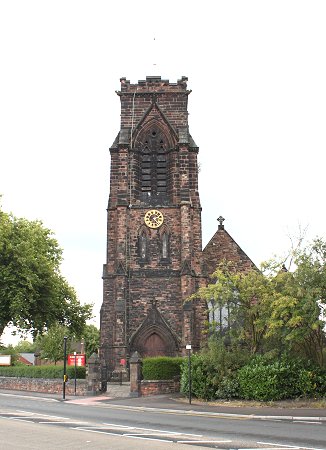
St. Giles’ Church. |
In 1709 when Dr. Thomas Manningham became
Dean of Wolverhampton, he received a petition from the people of
Willenhall and Bilston, which stated that they were greatly
inconvenienced by having to carry their dead to Wolverhampton
for burial. They asked for their respective chapels and chapel
yards to be consecrated for the proper burial of the dead.
The
new Dean arranged a meeting with the prebendaries to discuss the
matter. At the meeting they agreed to the parishioners’ demands,
on the understanding that the standard burial fee should still
be paid to St. Peter’s, along with a fee to the chapel for the
funeral service and burial. The local population also had to
agree to pay the consecration costs. This arrangement would also
be of benefit to Wolverhampton, because it would extend the life
of St. Peter’s cemetery, which even then would have been
filling-up at an increasing rate.
Even after the agreement, it took a long
time for any changes to take place. On 10th October, 1718 an
agreement between the ministers and local inhabitants was
signed, but the chapels were not consecrated until 14th August,
1727, a full 18 years after the process began.
|
|
Further unrest soon followed. Within a
decade, the standard fees payable to the parish hierarchy in
Wolverhampton greatly increased, and so the locals became angry.
They finally refused to pay for burials, christenings, and
standard church fees, which resulted in a great loss of income
for the Wolverhampton church. The quarrel worsened when it was
discovered that part of the increase in fees was for the repair
and maintenance of St. Peter’s Church, even including the church
clock.
The dispute continued for many years, by
which time the opposing sides were firmly entrenched. It
eventually came to trial in the High Court in 1755. During the
trial an old parish book was produced which listed the
proportion of rates that could be charged for the repair and
maintenance of St. Peter’s Church. It showed that the exorbitant
demands of Wolverhampton Parish were illegal.
The inhabitants of Willenhall and Bilston
did not have it all their own way. In 1756 a writ of prohibition
was filed to ensure that the cost of the trial, amounting to
£282.1s.8d. would be divided equally between Willenhall and
Bilston, and that any further proceedings would take place in
the spiritual courts. The writ also prohibited the carrying out
of marriages ceremonies in the Willenhall and Bilston chapels.

From an old postcard.
Marriages were not allowed to take place in
the Willenhall chapel until 1841 when the Bishop of Lichfield
granted a licence to the Vicar of Willenhall to perform
marriages. Even so the banns still had to be read in St. Peter’s
Church, and the couple had the right to be married there if they
so wished.
Willenhall finally freed itself from
Wolverhampton Parish around 1910 after the passing of a special
Act of Parliament to allow the reading of the banns at
Willenhall church, and the formation of the Parish of St. Giles.
On 4th December, 1845 two new
ecclesiastical districts were approved at a meeting of the
Willenhall Vestry and ratepayers, following a plan devised by
the Ecclesiastical Commissioners. They were St. Stephen’s, and
Holy Trinity, and were formed on 17th March, 1846. The districts
became parishes when suitable churches were built.
A third ecclesiastical district, St. Anne’s
was approved a few years later. It became a parish in 1861.
St. Giles’ Church
The old chapel of ease was
demolished in 1748 when the timber fabric of the
building became unsafe. The old stone tower
remained, and was incorporated into a new church.
|
|
The new building consisted of a nave, with six
simple rectangular windows on each side, and a small projection
at the far end that acted as a chancel. It was a plain
rectangular structure, built of brick, with a slate roof.
Externally it had little resemblance to a church other than the
old tower, and its ancient weathercock. In 1788 another storey
was added to the tower, to house a peal of 8 bells that were made
at Abraham Rudhall’s bell foundry in Gloucester.
Although the church was not generally
liked, nothing was done until the 1850s when plans were made to
improve the building. It was soon realised however that the
improvements that were envisaged, would be too costly, and so
plans were made to build a new church. By the early 1860s £7,000
had been raised for the project by public subscription. Plans
for the new church were drawn up by Wolverhampton architect Mr.
W. D. Griffin, who had previously designed the nearby St.
Stephen’s Church.
The new church, consisting of a substantial
sandstone-built structure, has a nave, aisles, chancel,
transept, and a new square tower, around 100ft. high. It was
consecrated on 18th July, 1867 by the Bishop of Lichfield, Dr.
John Lonsdale. Stained glass windows were soon added, thanks to
donations from the Gough family, the leveson-Gowers, the Earl of
Lichfield, the Clemsons, and others. |

A rear view of St. Giles’ Church. |
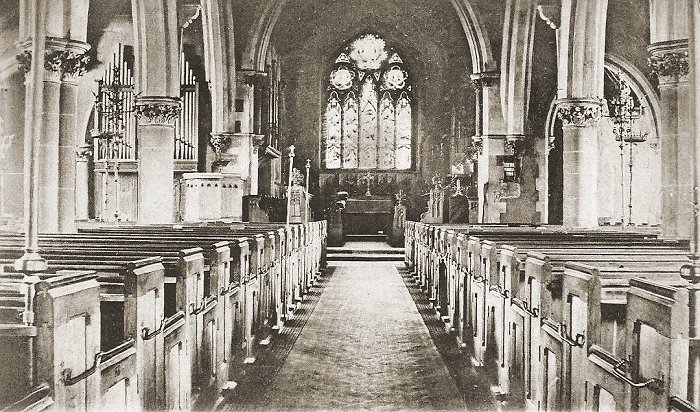
The interior of St. Giles’
Church. From an old postcard.
|
In 1897 the south chancel aisle, and the
south transept were added, and a year later the fine organ built
by Hill Norman and Beard was installed to commemorate Queen
Victoria’s Diamond Jubilee in 1897. Other additions included the
installation of choir stalls, the building of a church house,
and the enlargement of the churchyard.
In the 1930s the 8 bells were recast and
two others added to celebrate King George VI’s coronation in
1937. The 10 bells were cast at Gillett and Johnston’s bell
foundry in Croydon.
St. Stephen’s Church
|
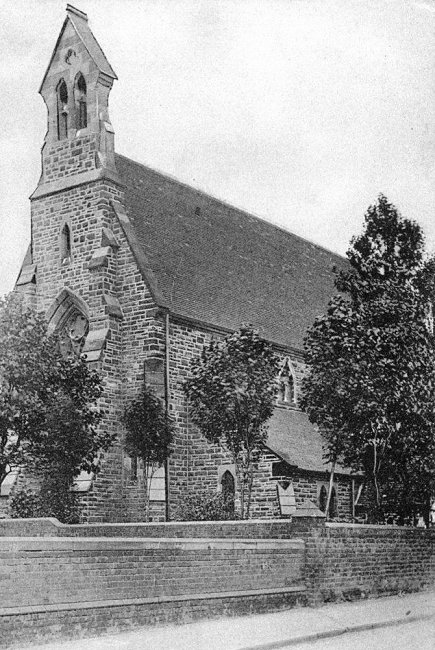
The original St. Stephen's
Church. From an old postcard. |
The first vicar of St. Stephen’s Parish,
the Rev. Thomas Woodcock was appointed in June 1848. He
initially had premises in Portobello, where he had a sizeable
congregation. The main task in hand was to build a parish
church.
Sufficient money soon became available from grants and
donations, and a suitable piece of land was acquired in
Wolverhampton Street. The new church, which took 18 months to
build, was designed by Wolverhampton architect W. D. Griffin,
and consecrated on 31st October, 1854.
The church suffered greatly from dry rot,
which resulted in its demolition in July, 1978. Building work on
a new church soon got underway. While the work was in progress,
services were held in the adjacent church hall.
The new
steel-framed building, with brick walls, was consecrated by
Bishop Barry Rogerson on the 8th September, 1979. It seats 112
people and contains many items salvaged from the old church,
including the altar, and the choir stalls.
|
Holy Trinity Church
The parish church of Holy Trinity stands in
Church Road, Short Heath. Soon after the formation of the
ecclesiastical district in 1846, the Rev. James Leckie became
the first vicar, who initially held services in a room in the
Jolly Collier Inn. Services soon moved to a suitable room in the
area which could seat 300 people. Its location is unknown.
James Leckie died in 1853 and was replaced
by the Rev. W. L. Rosedale. The new parish church was
consecrated on 25th July, 1855. A vicarage, and a day school
were soon added. The school closed in 1930. Much of the finance
for the new church was given by ironmaster Daniel Bagnall, who
owned the Coltham Iron and Coal Company; a Mr. Barnabas and
Sons; and Joseph Samuel Junior. The church has a nave, aisles, a
chancel, and is built of sandstone.
St. Anne’s Church
St. Anne’s Church opened in 1858 in Ann
Street as a mission church. It was built by Henry Jevons in
memory of his first wife, Ann Page, sister of Mrs G.
B. Thorneycroft. George Benjamin Thorneycroft, an
ironmaster at Shrubbery Iron Works in Wolverhampton,
became Wolverhampton’s first mayor in 1848.
|
|
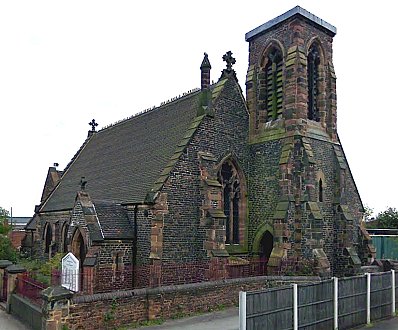
St. Anne's Church. |
The church was enlarged and consecrated on
St. George's Day, 23rd April, 1861 by Bishop Lonsdale. It then
became the parish church of the new parish of St. Anne’s. The
first vicar, the Rev. C. B. Twiss left in 1867 for St. Luke's
Church in Bilston.
The church is a substantial stone building
consisting of a nave, a north aisle, a north porch, a chancel,
and a small tower with one bell.
It was extensively renovated in
1904, and includes an oak chancel screen commemorating Mrs. Lavinia Brown, and an alabaster font.
A lady chapel was added in
1920, with an altar dedicated to the men of the parish who died
in action in the First World War. |
|
The Rise of
Non Conformity
The growth of non conformity in Willenhall
was greatly assisted by the antics of one of the town’s most
outrageous curates, the Rev. William Moreton.
His church life in Willenhall began as an
assistant to the Rev. Titus Neve, curate of Willenhall from June
1745 until his death on 23rd December, 1788. He led a
busy life because he was also Prebendary of Hilton from 1758,
and was appointed Rector of Darlaston in 1766. As time
progressed, and age began to take its toll, he relied upon
assistants to help with his many duties, both at Darlaston and
Willenhall. His first assistant was George Lewis who helped-out
from December 1778 until July 1779. Lewis signed the church
registers as the ‘clerk, curate’. Neve’s next assistant was
William Moreton, who assisted him until his death.
On the 11th May, 1789 an election for a new
curate was held. The candidates were the Rev. William Moreton,
and the Rev. A. B. Haden. Moreton was the outright winner with a
good 2 to 1 majority, receiving 67 votes. Hadon received only 29
votes. Although Moreton had been duly elected by the
parishioners, his nomination had to be signed by the Lords of
the Manor, which they refused to do. Presumably because of his
reputation.
|
| The saga continued for several years, first
coming before the Court of the Kings Bench, and later the High
Court of Chancery, where the Lord Chancellor ordered a second
poll.
This took place on the 7th December, 1795 with the same
outcome as the previous election.
The candidates were the Rev.
William Moreton, the Rev. A. B. Haden, and the Rev. Charles Neve,
son of Titus Neve, and Rector of Brierley Hill. Moreton received
55 votes, Haden received 22 votes, and Neve received no votes at
all.
After the election, the Lord Chancellor decreed that Moreton
would become the minister at Willenhall. |

The Rev. William Moreton. From
Hackwood's Annals of Willenhall. |
|
The lawsuit to establish Moreton’s right to
the curacy cost him dear. In about 1812 he was compelled to make a deed of arrangement
with his creditors to cover the legal costs. The trustee under
the deed was Thomas Hincks, a prosperous Willenhall maltster.
Hincks was instructed to pay Moreton £2 per week from the
revenues of the living, and use the remainder to pay off the £34
owed to the creditors. In reality this seems never to have
happened because when Moreton died, the money had still not been
paid.
As previously mentioned, Moreton’s antics
and his notoriety greatly harmed the reputation of St. Giles’
Church and resulted in many parishioners becoming Baptists or
Methodists. He was a drunkard who upset local landowners by
poaching on their estates. He also enjoyed the unsavoury
activities of cock fighting, bull baiting, and dog baiting.
In his book ‘A History of Willenhall’
Norman Tildesley included the following report which appeared in
the Wolverhampton Chronicle on Wednesday 2nd March, 1791:
On Monday the 21st ult. The Rev. W.
Moreton, Curate of Willenhall was convicted before J. Marsh Esq.
and fined in the penalty of £5 for sporting with a gun and two
setting dogs, upon the Manor of H. Vernon Esq. of Hilton Park,
in this county, not being duly qualified.
Moreton’s outrageous lifestyle continued
until his death on the 16th July, 1834.
Little London Baptist Church
The first non conformists in
the town were Baptists. In 1783 Mr. Thomas Jones preached in the streets of
Little London, which resulted in a Mr. William Wootton opening
his house for public worship. In 1784 Mr. Richard Bayliss, a Baptist
minister from Coseley preached in Wootton’s house. As a result
10 people were baptised and became members of the
church at Coseley. |
|
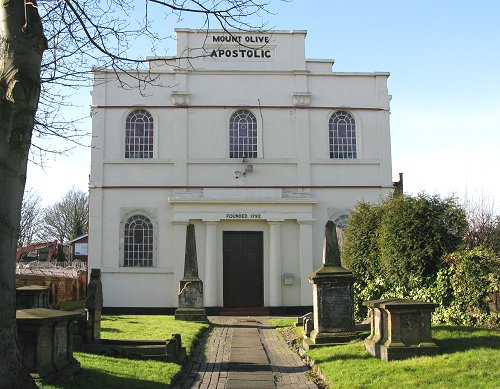
The former Little London Baptist Church. |
In 1787 a small meeting house was
set up by Mr. Jonah Bratt, to become a branch of the
Coseley Church.
By 1792 the numbers had greatly increased,
and so the decision was taken to form a separate
church; the Little London Baptist Church,
founded on 9th February, 1792. The first pastor was
William Bayliss.
After his death in 1804, the
meeting house, which only catered for 80 people, was
considered to be too small, and so in 1810-11 a new
church was built in Temple Bar. It opened in June
1811. |
| In 1837 the church opened its first school on a
plot of land in Back Lane, now called Cemetery Road.
The congregation continued to grow, and yet again
the church became
too small. It was replaced by the existing building,
which opened on the 15th June, 1851.
In 1862 members of the
congregation founded
a second church in Gomer Street, and a third in
Upper Lichfield Street. The Gomer Street church was
under the ministry of Richard Turner of Netherton,
and continued in use until 1884 when the building
had to be vacated. On 7th February, 1884 a message
was sent from Little London Baptist Church to invite
the congregation at Gomer Street to move there,
which they duly did. The
first united service was held at Little London on
Sunday 1st June, 1884.
In
1919, the course of the Calves Croft footpath at the rear of the church was
altered to make space for a new school. The old school
was sold in the same year, and the new two-storey school building
opened in 1925.
In the mid 1930s a fire destroyed the lower floor
of the school. At the time there were around 100
members of the congregation. In 1942 the church
celebrated its 150th anniversary, and on 25th
October, 1945 there was a thanksgiving for victory
service which included an organ recital to celebrate
the refurbishing of the organ. |
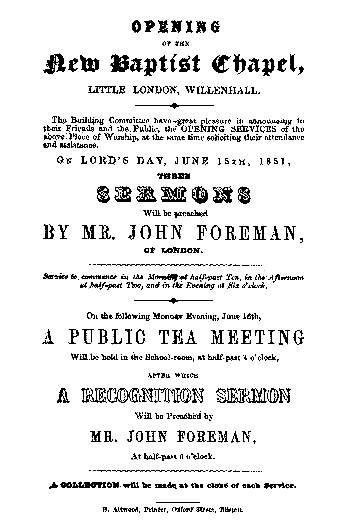
A notice advertising the
opening of the church. |
| On Tuesday 12th March, 1963 tragedy struck when
a fire destroyed much of the school. It caused
£3,500 worth of damage. The fire insurance only
covered about 80% of the cost of the repairs and so a fund
was set up to raise the outstanding money. In
February 1970 masonry fell from the chapel roof,
which was quickly inspected by a local architect. The
pediment on the gable end was found to be unsafe,
after suffering frost damage, and had to be removed.
In the same year the church decided to rent the
house at number 29 Banks Street as a house for the
pastor.
In recent times the size of the congregation
fell. In 1988 the gas heaters were condemned, and so
mobile gas heaters were purchased as the only
affordable solution. On May 16th and 17th, 1992 the
200th anniversary of the church was celebrated, but
the upkeep of the building was becoming
unaffordable. In January 1993 Sunday services were
held in the school room, due to the cold in the
church. |
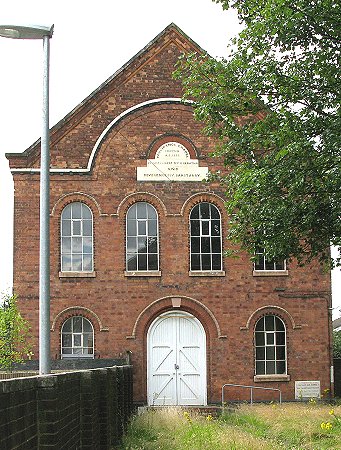
The former
Providence Baptist Chapel in New Road,
built in 1879. |
The building began to
deteriorate because of the high levels of moisture
from the gas heaters. There were also holes in the
roof, and under health and safety requirements an
external store would have to be built for
replacement gas cylinders.
The remaining members realised
that the church could not continue in its present
state, and a new venue had to be found. The
congregation decided to move to Little London
Community Centre which could be hired at a
reasonable cost. They held their last service at the
church on 27th February, 1994.
The building was then acquired
by the Mount Olive General
Assembly of Our Lord Jesus Christ.
The building was Grade II Listed on 24th
June, 1994, and is described in the listing as being built of
English bond red brick, with a stuccoed front, and slate roof.
It has galleries on three sides with an entrance on the east
front under the gallery, and an early 20th century Sunday school
at the back. The galleries have panelled fronts and are supported on slender columns, with an
almost complete set of panelled box pews. The organ dates from
the late 19th century.
|
|
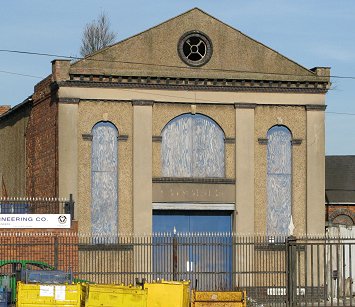
The former United Methodist
Chapel in Froysell Street. |
|

The former Baptist Chapel in
Upper Lichfield Street. |
|
Methodism
Frederick Hackwood includes a section on
the growth of Methodism in his book “The Annals of Willenhall”.
The following two paragraphs are from his book:
According to Mr. A. Camden Pratt, in his
“Black Country Methodism”, the earliest Methodist services were
open-air meetings held round a big boulder on the corner of
Monmore Lane. Then the nucleus of a Willenhall congregation was
formed at a cottage in Ten House Row; outgrowing its
accommodation here, a removal was next made to a farmhouse with
a commodious kitchen at Hill End.
The leaders and preachers came from
Darlaston, and it was not till 1830 that Willenhall was favoured
with a resident “travelling preacher”, and the provision of a
Wesleyan Chapel – it was on the site of the present Wesleyan Day
Schools. The cause flourished and grew mightily; chapels were
established at High Street, Portobello; Walsall Road (1865),
Monmer Lane, and Union Street.
The Wesleyan Church on the corner of Wesley
Road and Coltham Road opened for worship on the 11th April, 1882.
Mr. Tildesley laid the foundation stone on 11th
July, 1881. The building cost around £2,000. It
was the 3rd Methodist Church built in Coltham Road after the
arrival of Methodism around 1826. |
|
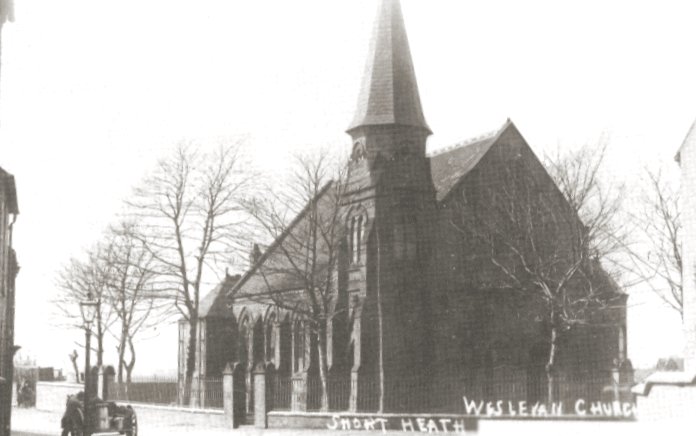
The Wesleyan Church on the
corner of Wesley Road and Coltham Road. From an
old postcard. |
|
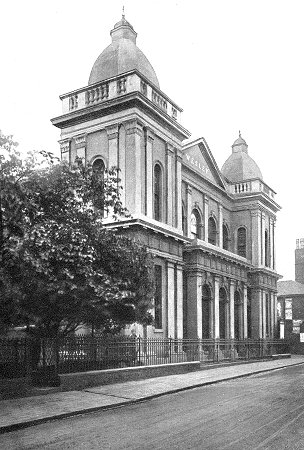
Union Street Methodist Church. |
The first church
opened in 1826, but soon became too small, and so a second
church was built next door. The 2nd church remained in use until
1882 when the current church was built. It then became a
schoolroom, until 1908 when the pupils were transferred to New
Invention School. It was demolished in 1971.
Many well-known local people became staunch
Methodists, including James Carpenter, of Carpenter and
Tildesley, Jonah Tildesley, and his sons and grandsons; James Tildesley who married Harriet Carpenter; and John Harper who
founded Albion Works.
Primitive Methodism began in Monmer Lane,
and then spread to Little London. Chapels were built at Lane
Head, New Invention, Russell Street, and Spring Bank.
An early Primitive Methodist Chapel stood
on Chapel Green, until it was replaced by a larger building in
Russell Street, which opened on 23rd March, 1850. The chapel
survived until the 1960s when the size of the congregation fell
to 137 due to the large scale demolition of the old houses in
the area, as part of Willenhall’s slum clearance scheme. The
last service was held on 3rd January, 1965. The
church joined forces with Walsall Street Methodist
Church and Union Street Wesleyan Church to form the New Trinity Methodist
Church, in Union Street. |
| A modern view of the
former Union Street Methodist Church, which closed
in 1996 after 191 years of worship.
It is now the Life
and Light Christian Centre. |
 |
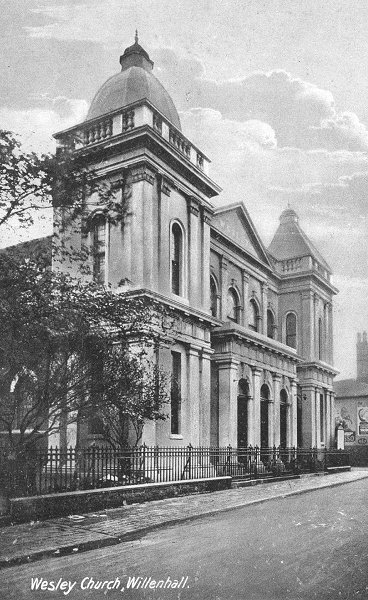 |
Another view of Union
Street Methodist Church.
From an old postcard. |
| Another postcard
showing views of Union Street Methodist
Church. |
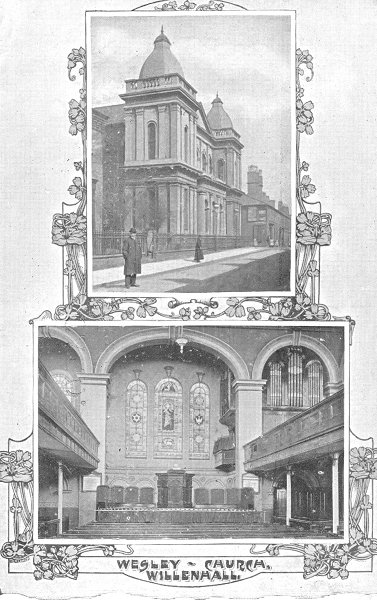 |
|
The Church of St. Mary
The Roman Catholics established a small
mission at the bottom of Union Street in the middle of the 19th
century. In 1860 they built St. Mary’s Church in Hall Street, as
a chapel of ease.
The Church of God, of Prophecy
The Church of God, of Prophecy, in St.
Anne’s Road was built in 1873. It was formerly Spring Bank
Methodist Church and belonged to one of the two Methodist
circuits which operated in the Willenhall area during the 1940s
and 1950s. Around 1861 St. Ann’s National
School was built next to the church. It had 240 pupils, and in
the 1880s was
run by Charles Stockham and his wife Hannah.
By the 1950s there were 10 Methodist and 3
Baptist chapels in the town, and also the Salvation Army.
Another
Interesting Election
|
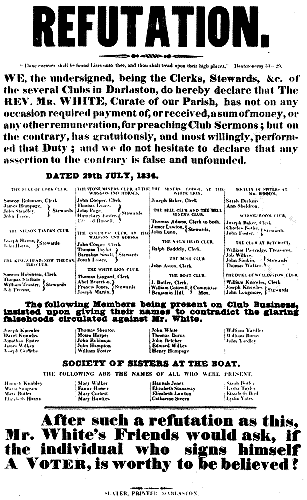
This poster was printed
to refute the rumour that the Rev. White, curate of Darlaston was
charging for preaching at local clubs. |
After the death of the Rev. William Moreton, an
election was held for his replacement as minister at
St. Giles' Church.
The candidates were as follows:
| The Rev. George Hutchinson Fisher
who came to Willenhall in 1832 as
William Moreton's assistant. |
| The Rev. Thomas Howells, curate of
Tipton. |
| The Rev. George William White,
curate of Darlaston. |
| The Rev. R. Robinson, lecturer at
St. Peter's Church, Wolverhampton. |
| The Rev. Thomas Rogers, headmaster
of Walsall Grammar School. |
| The Rev. John Gwyther, curate of
Chilvers Coton. |
| The Rev. William Vernon of
Willenhall. |
Defamatory rumours about some of
the candidates were spread amongst the
electorate in an attempt to change the course of
the election.
All of the candidates issued
election addresses which were handed out to the
electorate, and posters were displayed around
the town.
Much paper was consumed in an
attempt to refute the rumours.
|
The text on the poster above
is as follows:
Refutation.
“Thine enemies shall be found Liars unto
thee, and thou shalt tread upon their high places.” Deuteronomy
33 - 29.
We the undersigned, being the Clerks,
Stewards, &c. of the several Clubs in Darlaston, do hereby
declare that The Rev. Mr. White, Curate of our Parish, has not
on any occasion required payment of, or received, a sum of
money, or any other remuneration, for preaching Club Sermons;
but on the contrary, has gratuitously, and most willingly,
performed that Duty; and we do not hesitate to declare that any
assertion to the contrary is false and unfounded.
Dated 29th July, 1834.
| The Duke of York
Club |
|
The Colliers Club at
the Waggon and Horses |
|
The Nag’s Head Club |
|
School Room Club |
Simeon Robinson, Clerk
James Humpage, John Standley, and John Teece,
Stewards |
|
John Cooper, Clerk
Thomas Taylor, Barnabas Small, and Jonah Foster,
Stewards |
|
Ralph Baddely, Clerk |
|
Joseph Baker, Clerk
Charles Butler, and John Foster, Stewards
|
| The Nelson Tavern
Club |
|
The White Lion Club |
|
The Bush Club |
|
The Club at Butcroft |
|
Joseph Harris, and John Harris,
Stewards |
|
Thomas Lingard, Clerk
Abel Bruerton, Francis Jones, and Joseph Martin,
Stewards |
|
John Aston, Clerk |
|
William Partridge, Treasurer
Job Wilkes, John Simkin, and Thomas Walker, Stewards |
| The King’s Head (now
the Castle) Club |
|
The Miners Lodge at
the White Lion |
|
The Boat Club |
|
The Duke of
Wellington Club |
|
Simeon Robinson, Clerk
Thomas Statham, William Tranter, and Job Perrins,
Stewards |
|
Joseph Baker, Clerk |
|
J. Butler, Clerk
William Cotterill, and Benjamin Hill, Committee
Members |
|
William Knowles, Clerk
Joseph Knowles, and John Longmore, Stewards |
| The Stone Miners
Club, at the Waggon and Horses |
|
The Bell Club and
the Well Miner’s Club |
|
Society of Sisters at Mr. Woods |
|
|
John Cooper, Clerk
Thomas Evans, John Page, Humphrey Foster, and Edward
Russell, Stewards |
|
Thomas Adams, Clerk to
both.
James Lawton, and John Lunn, Stewarts |
|
Sarah Dickins
Ann Sheldron |
|
|
| The following Members being
present on Club Business, insisted upon giving their
names to contradict the glaring falsehoods
circulated against Mr. White. |
|
Joseph Knowles
David Knowles
Jonathan Foster
James Wilkes
Joseph Griffiths |
|
Thomas Shenton
Moses Harper
John Robinson
John Hampton
William Foster |
|
John White
Thomas Burns
John Belcher
Edward Wilkes
Henry Humpage |
|
William Yardley
William Burns
John Yardley |
|
Society of
Sisters at the Boat
The following are the names of all who were present. |
|
Hannah Kimbley
Maria Simpson
Mary Butler
Elizabeth Harris |
|
Mary Walker
Fanny Homer
Mary Corbett
Mary Hawkes |
|
Hannah Jones
Elizabeth Stanaway
Elizabeth Lawton
Catherine Sivern |
|
Sarah Butler
Lydia Taylor
Elizabeth Bird
Lydia Yates |
After such a refutation as this, Mr.
White’s Friends would ask, if the individual who signs himself A
VOTER, is worthy to be believed!
Slater, Printer Darlaston
| The text on the poster opposite is as follows:
The Rev. G. W. White, and his
“REFUTATION”
TO THE
ELECTORS
OF Willenhall
Gentlemen,
I am sure you must have read with feelings of
disappointment, the “Refutation” (?) as it is
called, of the Rev.
George William White
Truly, instead of its present
title with a quotation from Deuteronomy, a more
appropriate motto would have been, “The mountains
were in labour and brought forth a Mouse! After 8
days were spent in its conception, (the obstetric
assistance of his friends being called in) you are
presented with a paltry equivocation, the mere
abortion of a denial, as to one of the truths
contained in the statement of “A Voter.”
I now ask Mr. White whether Money has not
usually, if not invariably, been paid by clubs for
their sermons? – Whether he has not himself received
money?
Did he not on one occasion not very remote, when
the clubs were about to enter the church, hold a
debate with them at the door; and on none-compliance
with his terms, |
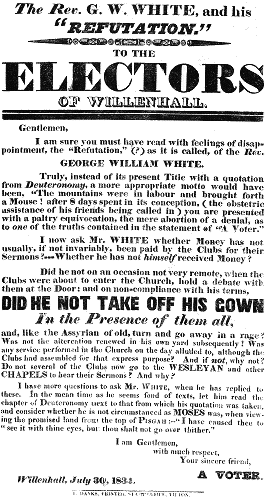
This poster was produced in
response to the Rev. White's poster. |
DID HE NOT
TAKE OFF HIS GOWN
In the Presence of them all,
and, like the Assyrian of old, turn and go
away in a rage? Was not the altercation renewed in his own yard
subsequently? Was any service performed in the church on the day
alluded to, although the clubs had assembled for that express
purpose? And if not, why not? Do not several of the clubs now go
to the Wesleyan and other chapels to hear their sermons? And
why?
I have many more questions to ask Mr.
White, when he has replied to these. In the mean time as he
seems so fond of texts, let him read the chapter in Deuteronomy
next to that from which his quotation was taken, and consider
whether or not this is circumstanced as Moses was, when viewing
the promised land from the top of Pisgah:- “I have caused thee
to “see it with thine eyes, but thou shalt not go over thither.”
I am Gentlemen,
with much respect,
Your sincere friend,
A VOTER
Willenhall, July 30, 1834.
I. Danks, Printer, Tipton
|
|
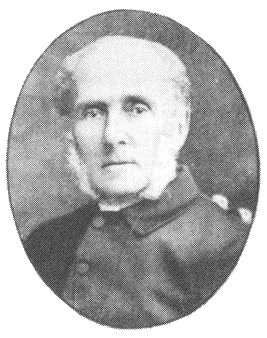
The Rev. George Hutchinson
Fisher.
From Hackwood's Annals of Willenhall. |
The poll took place on the 5th and 6th of
August, 1834 and was won by George Hutchinson Fisher. He had to
wait another four years before he could take up the post because
an appeal was lodged to make the election void, on the grounds
that 'faggot voting' had been employed. This practice, once
common, occurred when someone not legally entitled to vote,
could do so by acquiring property in the area.
Although the
appeal went through the courts, the result of the election was
upheld. The Rev. Fisher remained in office until his death in
1894. |
 |
|
 |
|
 |
Return to
Life in
the 19th Century |
|
Return to
the contents |
|
Proceed to
The
Industrial Town |
|